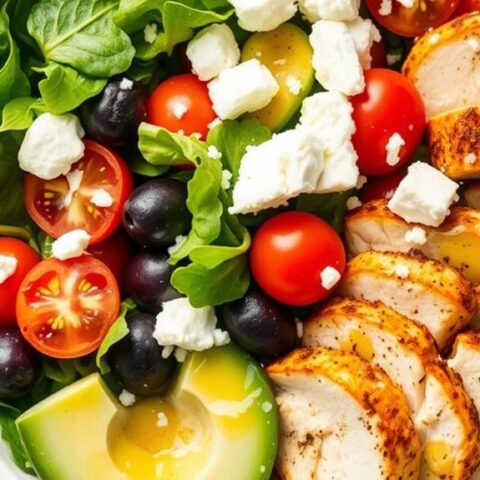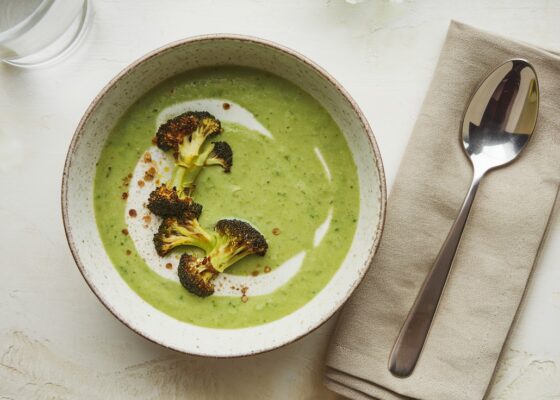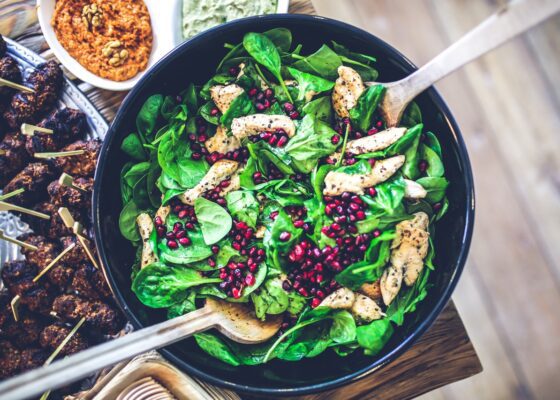
Gluten-free pizza crusts are not inherently low in carbohydrates, as they often contain high-carb ingredients like rice flour and tapioca starch. Traditional gluten-free crusts can contain up to 30 grams of net carbs per serving, while low-carb alternatives made with almond flour or cauliflower typically have 2-4 net carbs per slice. For those seeking both gluten-free and low-carb options, specialized recipes using nut flours or vegetable-based ingredients offer the best solution. Understanding the specific ingredients and their nutritional impact reveals numerous delicious alternatives.
Key Takeaways
- Gluten-free pizza crusts are not necessarily low-carb, as they often contain high-carb ingredients like rice flour and tapioca starch.
- Traditional gluten-free crusts can contain over 30g of carbs per serving, while low-carb alternatives have only 2-4g net carbs.
- For a low-carb pizza experience, choose crusts made with almond flour, coconut flour, or cauliflower instead of grain-based flours.
- Store-bought gluten-free crusts typically contain 26-36g carbs per serving, much higher than keto-friendly alternatives.
- The best low-carb pizza options include fathead dough, cauliflower crust, or chicken-based crusts, ranging from 1-5g net carbs.
Understanding Gluten-Free vs. Low-Carb Pizza Crusts
While many people associate gluten-free and low-carb pizza crusts as being the same thing, these two dietary options actually serve distinct purposes and often use different ingredient bases.
Traditional gluten-free recipes frequently rely on rice flour or tapioca starch, which can result in high carbohydrate content despite being safe for those with gluten sensitivities.
For those following a keto diet or seeking low-carb alternatives, specific ingredients like almond flour or cauliflower crust offer better options, typically containing only 2-4 net carbs per slice.
The key distinction lies in the low carb flour choices, as not all gluten-free recipes automatically qualify as low-carb.
To achieve both dietary goals, consumers should specifically seek products or gluten-free pizza recipes that use nut-based or vegetable-based ingredients rather than assuming gluten-free options will be low in carbohydrates.
Additionally, using keto-friendly sweeteners such as stevia or erythritol can help maintain the low-carb nature of recipes without disrupting ketosis.
Common Ingredients in Traditional Gluten-Free Pizza Bases
Traditional gluten-free pizza bases incorporate a distinctive combination of ingredients that work together to replicate the texture and binding properties typically provided by wheat flour.
Common ingredients include high-carb components such as rice flour, tapioca flour, and potato starch, which serve as the primary structural elements in these crusts.
While some recipes incorporate lower-carb alternatives like almond flour, the nutritional profile of most traditional gluten-free bases remains carbohydrate-heavy.
These flour blends often require additional ingredients to improve texture and taste, including added sugars and preservatives, which can further increase the carbohydrate content.
Understanding these ingredient combinations is essential for consumers monitoring their carb intake, as gluten-free doesn't necessarily equate to low-carb in pizza crusts.
Best Low-Carb Alternatives for Pizza Crust
For individuals following a low-carb lifestyle, several alternatives to traditional gluten-free pizza crusts offer satisfying solutions without compromising dietary goals. The most popular low-carb alternatives provide significant nutritional benefits while maintaining the beloved pizza experience.
| Crust Type | Net Carbs Per Serving |
|---|---|
| Fathead (almond flour) | 2-4g |
| Cauliflower pizza | 3-5g |
| Chicken-based crust | 1-2g |
| Commercial low-carb mix | 0-2g |
| Coconut flour blend | 3-4g |
These keto pizza crust options range from the classic Fathead dough, which combines almond flour with cheese, to innovative high-protein pizza bases made from chicken. Cauliflower pizza has gained popularity as a vegetable-based alternative, while commercial mixes offer convenience without compromising low-carb goals. Each option provides the satisfying texture and taste of traditional pizza while keeping net carbs minimal. Leafy greens and other above-ground vegetables can be excellent toppings to enhance flavor and nutrition while adhering to keto guidelines.
Calculating Net Carbs in Your Pizza Base
The carbohydrate content in gluten-free pizza crusts varies considerably, with almond flour-based options containing as few as 2-4 net carbs per slice, while traditional rice flour crusts can exceed 30 grams.
Understanding net carbs requires subtracting the total fiber content from the total carbohydrates, as fiber doesn't impact blood sugar levels.
Accurate tracking of net carbs can be achieved through nutritional tools like Cronometer, while incorporating high-fiber ingredients such as cauliflower or zucchini can greatly reduce the overall carb count.
Carb Content Varies Widely
Net carbohydrate content represents one of the most notable variables among gluten-free pizza crusts, with amounts ranging from as little as 2 grams to over 30 grams per serving.
While traditional gluten-free crusts often contain high-carb ingredients like rice flour, modern low-carb alternatives provide considerably reduced net carbs.
Consider these key variations in carb content:
- Traditional gluten-free crusts made with rice flour: 25-30g net carbs per serving
- Almond flour-based pizza crusts: 4-6g net carbs per serving
- Keto pizza crusts (cauliflower or cheese-based): 2-5g net carbs per serving
Understanding these differences allows consumers to make informed choices based on their dietary needs.
Alternative flours like almond and coconut provide viable options for those seeking to reduce their carbohydrate intake while maintaining a gluten-free diet.
Fiber Vs Total Carbs
Understanding carbohydrate calculations becomes particularly relevant when considering gluten-free pizza bases, as accurate tracking helps maintain dietary goals.
When evaluating pizza crust options, the key distinction lies in calculating net carbs by subtracting fiber from total carbs, since fiber doesn't impact blood sugar levels.
For those following a low-carb diet, gluten-free alternatives made with almond flour often provide favorable carbohydrate counts. However, careful label reading remains essential, as some gluten-free products contain hidden sugars that can increase total carbs.
The calculation method is straightforward: if a pizza crust contains 20 grams of total carbs and 5 grams of fiber, the net carbs would be 15 grams. This knowledge enables consumers to make informed choices while maintaining their dietary requirements.
Net Carb Calculation Methods
Calculating net carbs in gluten-free pizza bases requires a straightforward mathematical approach that helps individuals maintain their dietary goals with precision. To determine net carbs, subtract the fiber content from total carbohydrates in your pizza crust ingredients.
When evaluating gluten-free pizza crusts, consider these essential calculation steps:
- Document total carbohydrates and fiber content for each ingredient.
- Use nutritional tracking tools like Cronometer for accurate measurements.
- Replace high-carb flours with low-carb alternatives like almond flour or coconut flour.
While traditional gluten-free crusts often contain high-carb ingredients like rice or tapioca flour, focusing on low-carb alternatives can markedly reduce the net carb count.
This calculation method enables precise tracking and helps maintain dietary goals while enjoying gluten-free pizza options.
Essential Tips for Making Keto-Friendly Pizza Crust
When creating a keto-friendly pizza crust, selecting the right low-carb ingredients serves as the foundation for success. Almond flour and coconut flour emerge as excellent alternatives to traditional wheat flour, considerably reducing the carbohydrate content while maintaining a satisfying texture. The incorporation of mozzarella cheese and cream cheese helps bind the ingredients together, creating a sturdy base with approximately 2 grams of net carbs per slice. To achieve ideal results, pre-bake the crust for 6-8 minutes before adding toppings, ensuring a crispy texture that holds its shape. For those seeking alternatives, ingredients substitutions can accommodate different dietary needs – consider using flax eggs for a vegan version or experimenting with various seasonings to enhance flavor while maintaining the low-carb profile of this gluten-free option. Incorporating psyllium husk powder can enhance the texture of your pizza crust, providing additional fiber without compromising the low-carb nature of the dish.
Popular Store-Bought Options and Their Carb Content
Maneuvering through the grocery store's selection of gluten-free pizza crusts requires careful attention to nutritional content, particularly for those monitoring their carbohydrate intake. Many store-bought options contain surprisingly high carbohydrate counts, which may not align with low-carb diets. Common gluten-free options and their carb content per serving: 1. Caulipower Cauliflower Crust: 26g carbs 2. Udi's Gluten Free Pizza Crust: 28g carbs 3. Trader Joe's Gluten Free Pizza Crust: 36g carbs. For those prioritizing ingredient awareness and following strict low-carb diets, specialized products like Keto Pizza Crust Zero Carb Mix offer alternatives with notably lower carbohydrate content, containing just 1 gram of net carbs per serving. This stark difference highlights the importance of carefully reading nutritional labels when selecting gluten-free pizza crusts. It is also essential to avoid refined carbohydrates like white bread and pasta, which can disrupt ketosis and hinder low-carb diet goals.
Homemade Low-Carb Pizza Crust Recipes
Creating a successful low-carb pizza crust at home begins with selecting versatile base ingredients such as almond flour, coconut flour, or cauliflower, which serve as excellent alternatives to traditional wheat flour. The essential components typically include binding agents like eggs and cheese, along with specialty ingredients such as psyllium husk or flax seeds to achieve the desired texture and structure. Proper baking techniques, including pre-baking the crust before adding toppings and maintaining appropriate oven temperatures, guarantee a crispy, sturdy foundation that rivals conventional pizza crusts while keeping carbohydrates minimal. For those seeking additional options, incorporating ingredients like zucchini noodles can enrich the low-carb experience by adding nutritional value and variety.
Popular Crust Base Options
Low-carb pizza crusts have revolutionized the way health-conscious individuals enjoy their favorite Italian dish. Several gluten-free base options provide excellent alternatives while remaining low in carbs and compatible with various pizza toppings.
The key to success lies in selecting the right ingredients and proper preparation techniques.
Popular low-carb pizza crust recipes include:
- Cauliflower pizza crust: Requires removing excess moisture from riced cauliflower before combining with cheese and eggs.
- Almond flour crust: Creates a chewy texture while providing only 2 grams of net carbs per slice.
- Fathead dough: Combines mozzarella, cream cheese, and almond flour for a sturdy base.
Additional options include coconut flour crust, which requires more eggs due to its absorbent nature, and protein-rich chicken crust made from shredded chicken and cheese.
Essential Ingredients Guide
Success in crafting homemade low-carb pizza crusts depends on selecting and combining the right ingredients in precise proportions. The essential ingredients for creating a gluten-free, low-carb crust include almond flour or alternative grain-free flours, combined with mozzarella cheese and cream cheese for ideal texture. The popular Fathead pizza crust demonstrates how these ingredients work together to create a chewy, satisfying base.
| Ingredient | Purpose |
|---|---|
| Almond Flour | Structure & Low-Carb Base |
| Mozzarella | Binding & Texture |
| Cream Cheese | Moisture & Pliability |
| Baking Powder | Rise & Lightness |
A well-executed low-carb crust requires careful attention to measurements and proper mixing techniques, ensuring ingredients combine effectively to achieve the desired texture and structural integrity.
Baking Tips and Techniques
The art of baking a perfect low-carb pizza crust requires mastering several essential techniques and temperature controls. When working with almond flour or other keto-friendly ingredients, precise preparation guarantees peak texture and minimal net carbs.
Key baking tips for achieving the ideal low-carb crust include:
- Pre-bake the crust for 6-12 minutes before adding toppings to establish a firm foundation.
- Pierce the dough surface thoroughly with a fork to prevent unwanted bubbling during baking.
- Monitor temperature carefully, as alternative flours can brown more quickly than traditional crusts.
Professional bakers recommend incorporating mozzarella and cream cheese into the dough mixture, which enhances both texture and flavor while maintaining the desired low-carb profile.
This combination, when properly executed, yields a crust that satisfies pizza cravings while adhering to keto dietary requirements.
Choosing the Right Flour Substitutes
Making delicious gluten-free pizza begins with selecting appropriate flour substitutes that can replicate the texture and structure of traditional wheat flour. Almond flour stands out as a popular low-carb option, containing only 2 grams of net carbs per tablespoon, while coconut flour offers another alternative, though it requires additional eggs for binding.
For those seeking nut-free solutions, sunflower seed flour provides comparable results to almond flour, despite minor differences in color and texture.
Cauliflower crusts represent an innovative approach, using riced cauliflower as a base to create gluten-free pizzas with minimal carbohydrates.
When exploring flour substitutes, it's essential to examine product labels carefully, as hidden sugars and starches in some gluten-free options can greatly increase the overall carb content, potentially undermining low-carb dietary goals. Pay close attention to the ingredient lists on these products to ensure they align with your keto objectives and avoid hidden sugars.
Mastering the Perfect Cheese-Based Pizza Base
Creating the perfect cheese-based pizza crust requires careful attention to both cheese selection and temperature control during preparation.
Choosing high-quality, meltable cheeses like mozzarella and cream cheese guarantees ideal binding properties, while incorporating them at the right temperature prevents separation and promotes even distribution throughout the mixture.
The combination of properly melted cheese with almond flour creates a sturdy yet flexible base that can withstand various toppings while maintaining its structural integrity during baking.
Achieving Perfect Crust Texture
Mastering a perfect cheese-based pizza crust requires understanding the delicate interplay between melted cheese and low-carb flour alternatives. The combination of mozzarella and almond flour creates a sturdy foundation while maintaining minimal carbohydrates, often achieving just 2 grams per slice.
To achieve ideal texture and stability in your low-carb pizza crust:
- Knead the dough thoroughly while incorporating melted cheese at low temperatures.
- Pre-bake the crust before adding toppings to reduce moisture content.
- Experiment with cheese-to-flour ratios and include baking powder for enhanced airiness.
Proper dough formation techniques guarantee a crispy crust with firm edges, while careful ingredient selection maintains the desired texture.
The addition of cream cheese can improve pliability, resulting in a chewy consistency that closely mimics traditional wheat-based crusts.
Meltable Cheese Selection Tips
A pizza crust's success hinges on the careful selection of meltable cheeses that provide both structure and texture. For an effective low-carb, gluten-free pizza base, low-moisture mozzarella emerges as the best choice, offering superior meltability while maintaining minimal carbohydrate content.
The addition of cream cheese to the mixture helps prevent the crust from becoming too dense, creating a lighter, more appealing texture.
When combining these cheeses, avoid high-moisture varieties that can compromise the crust's integrity. The synergy between mozzarella and cream cheese creates a sturdy pizza crust with crispy edges, essential for replicating traditional pizza characteristics.
For safety and dietary compliance, always verify that selected cheeses carry gluten-free certification to prevent cross-contamination from gluten-containing ingredients.
Smart Topping Choices for Low-Carb Pizza
The right combination of toppings can transform a low-carb pizza from bland to extraordinary while maintaining its health benefits. When selecting toppings for a low-carb pizza, focus on ingredients that add flavor without increasing the carbohydrate content greatly.
Smart topping choices can elevate a low-carb pizza experience, delivering maximum flavor while keeping carbohydrates in check.
For ideal low-carb pizza creation, consider these essential guidelines:
- Choose protein-rich toppings like pepperoni, sausage, or chicken.
- Add non-starchy vegetables such as bell peppers, mushrooms, and spinach.
- Incorporate healthy fats through olive oil, avocado, or various cheeses.
Using unsweetened tomato sauce as a base and topping with mozzarella cheese creates a delicious foundation.
Enhance flavor with low-carb additions like olives, artichokes, and fresh herbs, while avoiding high-carb vegetables such as corn and sweet potatoes. Non-starchy vegetables like broccoli and cauliflower offer nutrient-dense options that support ketosis while providing essential vitamins and fiber.
Storing and Reheating Your Low-Carb Pizza
Proper storage and reheating techniques can greatly extend the life of low-carb pizza while maintaining its delicious taste and texture.
Leftover low-carb pizza can be safely refrigerated for up to seven days when stored properly in airtight containers.
For longer storage, freezing individual slices in a ziplock bag provides an excellent solution, preserving quality for up to six months.
When reheating refrigerated slices, a preheated oven at 180°C (350°F) delivers ideal results, while microwaving for 30 seconds offers a quick alternative.
For frozen slices, skip thawing and place them directly in an oven at 350°F for approximately 20 minutes. This method prevents sogginess and maintains the pizza's original texture.
Incorporating one-pot meals into your weekly meal prep can further streamline your cooking process, allowing you to enjoy more quality family time.
Proper storing and reheating methods guarantee every slice remains as enjoyable as when first made.
Frequently Asked Questions
Is Gluten Free Pizza Crust Low-Carb?
Gluten-free pizza crusts aren't inherently low-carb, as many gluten alternatives contain high carb content. However, specific food substitutions like almond flour can create low-carb options suitable for dietary preferences and gluten sensitivity.
How Many Carbs Are in a Gluten-Free Crust Pizza?
Gluten-free pizza crusts contain varying carbohydrate levels, typically ranging from 30-40 grams per regular slice with standard ingredients. Alternative carb-conscious options like cauliflower-based crusts offer lower counts between 3-10 grams per serving.
Is Gluten-Free Also Low-Carb?
Gluten-free products often contain high-carb alternatives like rice flour. For those following low-carb diets, careful attention to nutritional information is essential, as gluten sensitivity doesn't automatically equate to reduced carbohydrate content.
Which Pizza Crust Has the Least Carbs?
Cauliflower crust pizza typically contains the lowest carbs, with 1-2 grams per slice. Other low carb alternatives include almond flour and coconut flour crusts, which average 2-4 grams per slice.
Conclusion
While gluten-free pizza crusts aren't automatically low in carbohydrates, several alternatives make it possible to enjoy pizza while maintaining a low-carb lifestyle. Whether choosing cauliflower, almond flour, or cheese-based crusts, careful attention to ingredients and proper preparation techniques can create satisfying pizza bases with considerably fewer carbs than traditional options. By combining smart flour substitutes with mindful topping choices, pizza enthusiasts can craft delicious, health-conscious meals that align with their dietary goals.










No Comments